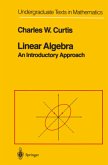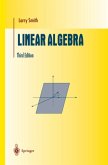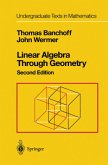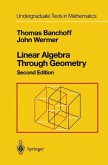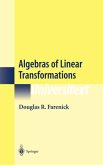This revised and updated fourth edition designed for upper division courses in linear algebra includes the basic results on vector spaces over fields, determinants, the theory of a single linear transformation, and inner product spaces. While it does not presuppose an earlier course, many connections between linear algebra and calculus are worked into the discussion. A special feature is the inclusion of sections devoted to applications of linear algebra, which can either be part of a course, or used for independent study, and new to this edition is a section on analytic methods in matrix theory, with applications to Markov chains in probability theory. Proofs of all the main theorems are included, and are presented on an equal footing with methods for solving numerical problems. Worked examples are integrated into almost every section, to bring out the meaning of the theorems, and illustrate techniques for solving problems. Many numerical exercises make use of all the ideas, and develop computational skills, while exercises of a theoretical nature provide opportunities for students to discover for themselves.
Linear algebra is the branch of mathematics that has grown from a care ful study of the problem of solving systems of linear equations. The ideas that developed in this way have become part of the language of much of higher mathematics. They also provide a framework for appli cations of linear algebra to many problems in mathematics, the natural sciences, economics, and computer science. This book is the revised fourth edition of a textbook designed for upper division courses in linear algebra. While it does not presuppose an earlier course, many connections between linear algebra and under graduate analysis are worked into the discussion, making it best suited for students who have completed the calculus sequence. For many students, this may be the first course in which proofs of the main results are presented on an equal footing with methods for solving numerical problems. The concepts needed to understand the proofs are shown to emerge naturally from attempts to solve concreteproblems. This connection is illustrated by worked examples in almost every section. Many numerical exercises are included, which use all the ideas, and develop important techniques for problem-solving. There are also theoretical exercises, which provide opportunities for students to discover interesting things for themselves, and to write mathematical explanations in a convincing way. Answers and hints for many of the problems are given in the back. Not all answers are given, however, to encourage students to learn how to check their work.
Linear algebra is the branch of mathematics that has grown from a care ful study of the problem of solving systems of linear equations. The ideas that developed in this way have become part of the language of much of higher mathematics. They also provide a framework for appli cations of linear algebra to many problems in mathematics, the natural sciences, economics, and computer science. This book is the revised fourth edition of a textbook designed for upper division courses in linear algebra. While it does not presuppose an earlier course, many connections between linear algebra and under graduate analysis are worked into the discussion, making it best suited for students who have completed the calculus sequence. For many students, this may be the first course in which proofs of the main results are presented on an equal footing with methods for solving numerical problems. The concepts needed to understand the proofs are shown to emerge naturally from attempts to solve concreteproblems. This connection is illustrated by worked examples in almost every section. Many numerical exercises are included, which use all the ideas, and develop important techniques for problem-solving. There are also theoretical exercises, which provide opportunities for students to discover interesting things for themselves, and to write mathematical explanations in a convincing way. Answers and hints for many of the problems are given in the back. Not all answers are given, however, to encourage students to learn how to check their work.
"This book is an important addition to the literature of linear algebra. It would be a pleasure to use it for a one-semester or two-quarter course intended for serious (and talented) students. This book deserves to be as influential with the current generation of mathematics students as was Halmos' Finite-Dimensional Vector Spaces with this reviewer's generation, 45 years ago." MATHEMATICAL REVIEWS
Fourth Edition C.W. Curtis Linear Algebra An Introductory Approach. "This book is an important addition to the literature of linear algebra. It would be a pleasure to use it for a one-semester or two-quarter course intended for serious (and talented) students. This book deserves to be as influential with the current generation of mathematics students as was Halmos' Finite-Dimensional Vector Spaces with this reviewer's generation, 45 years ago."-MATHEMATICAL REVIEWS


